Following an acknowledged master through his earliest forays into finding a style is like watching live over his shoulder in the studio. This process of tracking a highly regarded artist’s early development is only one of the pleasures to be found in “Richard Diebenkorn: Early Color Abstractions 1949-1955,” a lovingly focused exhibition of 30 early works on paper at Van Doren Waxter on East 73rd Street.
Another reward for visitors is the gratification of picking out a well-wrought painting on its own terms, such as the glowing essay in the primary colors of Untitled c. 1952-53 (CR 1190), with its dense blocks of scarlet and cardinal reds, sky blue corner and sunny arc of gold.
.
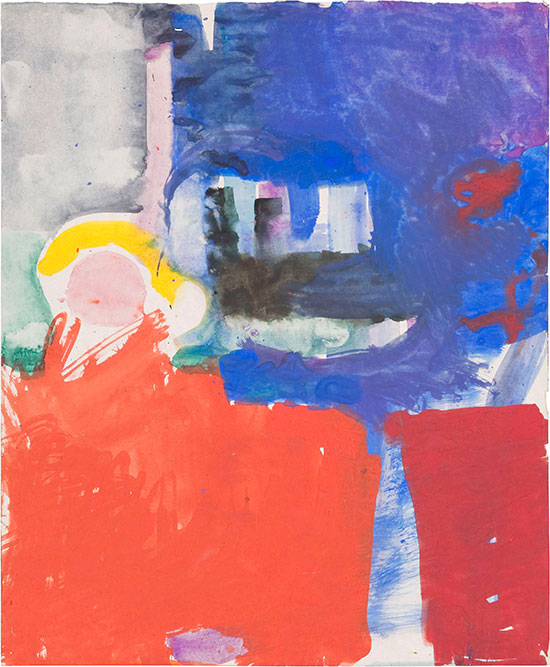
"Untitled" by Richard Diebenkorn, c. 1952-53. Gouache on paper, 17 x 14 inches. Catalogue raisonné no. 1190.
.
The early works are also refreshing reminders of the heroic struggle that is often involved. Reading the candid catalogue essay for the show—and discussing the show in the gallery with Dorothea Rockburne, a formidable artist whose development also passed through an Abstract Expressionist phase—refreshed my understanding that the path to the summit is not always smooth.
The show pitches some curveballs. Its chronological range, 1949 to 1955, places Diebenkorn in landscapes as well as aesthetic contexts different from those for which he is best known, namely San Francisco and the Los Angeles area, where he began his magisterial Ocean Park series in 1967. This exhibition fills out the geographical range of his career considerably, as most of the works were made in Sausalito, when he taught at the California School of Fine Arts (from 1947 to 1949) and in Albuquerque, during the time he pursued a master’s degree at the University of New Mexico, continuing to capitalize on the G.I. Bill.
As with the Ocean Park paintings, and the figural paintings in San Francisco, it is too tempting to read the works on paper at Van Doren Waxter in terms of landscape or figure rather than as pure abstractions. In Untitled c. 1952-53 (CR 1182), for example, there is a limpid blue patch of sky linked to a domed section of a blue globe on the left hand side over a sandy patch of desert that is pretty enough to suggest (I understand it sounds heretical) Georgia O’Keeffe’s paintings in New Mexico.
.
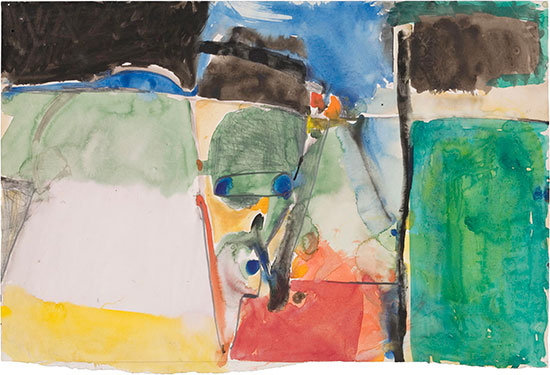
"Untitled" by Richard Diebenkorn, c. 1952-53. Watercolor and graphite on paper, 12 7/8 x 18 7/8 inches. Catalogue raisonné no. 1182.
.
Now considered a formidable figure in the history of West Coast art, Diebenkorn was born in Portland, Oregon, in 1922, and his father, a hotel supply executive, moved the family to the San Francisco Bay Area two years later. He attended Stanford and studied painting under Daniel Mandelowitz, who took him to the home of Sarah Stein, sister-in-law of Gertrude, to be exposed to Cezanne, Picasso and (an inevitable point of comparison) Matisse.
The transparent washes of blue over green, his inheritance from Cezanne and a signature painterly aspect of his work in oil, are gorgeously prefigured in this show in Untitled c. 1949-55 (CR 1148) as well as the oceanic mingling of white and blue in Untitled 1955 (CR 1467). He left Stanford in 1943 to become a Marine. Returning to San Francisco in 1946, he took courses on the G.I. Bill at the California School of Fine Arts and then taught there, finally completing the requirements for his B.A. from Stanford in 1949.
.
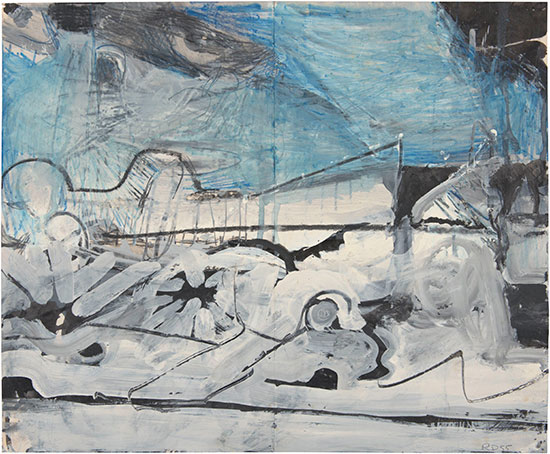
"Untitled" by Richard Diebenkorn, 1955. Gouache, crayon, graphite, and ink on joined paper, 12 1/2 x 15 1/4 inches. Catalogue raisonné no. 1467.
.
In 1950 he moved to New Mexico. As he said later, “In Albuquerque in a sense I was on my own. I’d left all my influences in San Francisco.” After Albuquerque he returned to Berkeley, becoming the leader of the local Abstract Expressionist movement and teaching at the California School of Fine Arts (which had by that time restored its original name: the San Francisco Art Institute) from 1959 to 1963. In 1966 he moved to Santa Monica and taught at UCLA until 1973. He died in Berkeley in 1993.
Nobody would expect the exhibition of a master to reveal weakness, but the main critical thesis of the too-brief catalogue essay by Mark Lavatelli for the exhibition links the “exploratory” character of the works at Van Doren Waxter to “awkwardness.” He isolates a plume of black ink that lurches right to left in Untitled, c. 1952-53 (CR 1179) in defiance of the elegance of the rest of the picture: “The beauty becomes awkward.”
.

"Untitled" by Richard Diebenkorn, c. 1952-53. Gouache on paper, 17 1/8 x 14 inches. Catalogue raisonné no. 1179.
.
The phrase echoes a conversation with Diebenkorn passed along from Wayne Thiebaud about “crudities and awkwardnesses” that prevent the work from being “slick.” As Thiebaud said, “It is redirection to avoid getting easy … Diebenkorn retains the stumbling.”
This seems an odd virtue to emphasize, but it recalls a brilliant observation made by the French philosopher Roland Barthes about the childlike scrawl Cy Twombly used to heavily inscribe words on his paintings. Barthes called this antithesis to calligraphy “gauche” in the literal sense of seeming to be done with the left hand.
The epitome of this “awkward” phase in the show can be seen in the bumbling graphite and painted forms in Untitled c. 1952 (CR 1148), in which the red and black, like sports fans in a stadium tunnel in their team colors, jostle together loudly. Diebenkorn’s shiny pencil shading even resembles Twombly’s ponderous hand here. It humanizes Diebenkorn to think of the labor and revision. It makes me admire him, and these works, all the more.
.
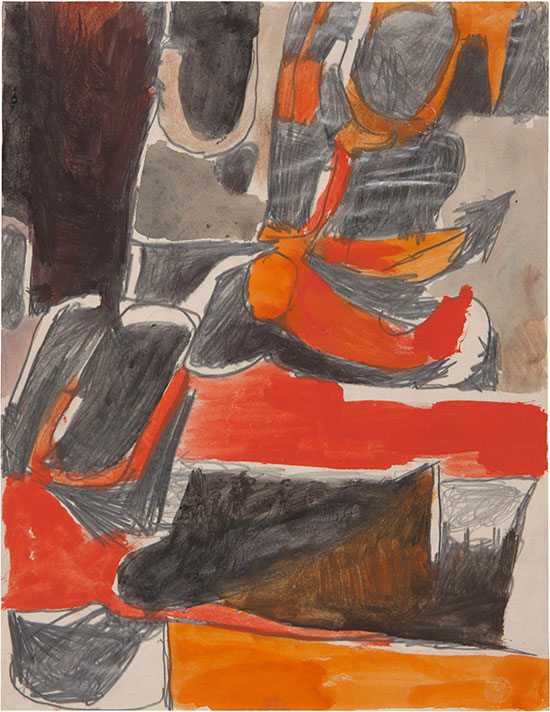
"Untitled" by Richard Diebenkorn, c. 1952. Gouache and graphite on paper, 11 x 8 1/2 inches. Catalogue raisonné no. 1148.
.
Then it becomes time to find the line from struggle to mastery. Because the Ocean Park works loom so large in his reputation, it is tempting to sort the rectilinear divisions in some of these early works on paper from the curves, and relate them to the vocabulary of the famous paintings. For example, Untitled c. 1949-55 (CR 2679) with its range of blues from bright cerulean to deep lapis lazuli and slate, or the blocked-out quadrants of Untitled c. 1950-53 (CR 790) with its gorgeous washes of emerald and forest greens, can be viewed as prefigurations. In the same way, the ruby reds and clouds of yellow soaked into the paper began to remind me of Kandinsky’s watercolor improvisations, particularly in Untitled c. 1949-55 (CR 604).
.
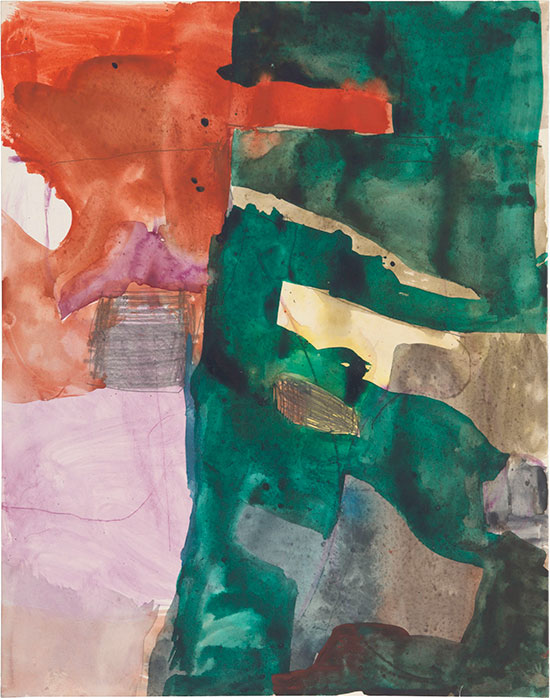
"Untitled" by Richard Diebenkorn, c. 1950-53. Gouache and graphite on paper, 14 x 11 inches. Catalogue raisonné no. 790.
.
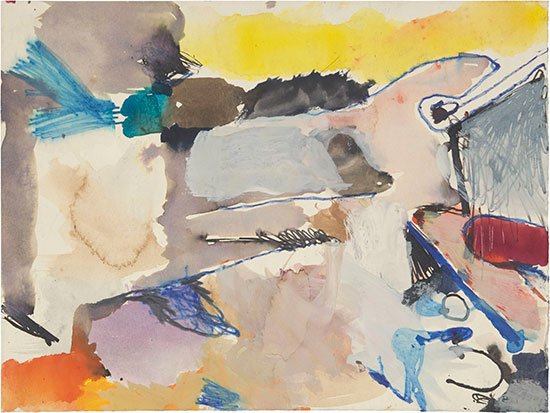
"Untitled" by Richard Diebenkorn, c. 1949-55. Watercolor and ink on paper, 9 x 12 inches. Catalogue raisonné no. 604.
.
Some reviewers have all the luck. The afternoon I dropped in at the hushed Van Doren Waxter townhouse space that offers a refuge to lovers of serious paintings and drawings, I was honored by the company of the renowned painter Dorothea Rockburne, who happened to be in the neighborhood to check out a group show in which some of her work was hung. She had swung by Van Doren Waxter where an earlier exhibition (which I had reviewed for Hamptons Art Hub) had included one of her drawings.
Rockburne has an encyclopedic mind and the eloquence to match. I had made her acquaintance at a dinner after an opening some months before, so I was not ashamed to solicit a few comments on the Diebenkorn works to pass along to readers. I received a generous master class in what it means to start as an Abstract Expressionist and explore, sometimes with that “awkwardeness” the essay points out, an individual path from that strong, dominant school.
She moved from work to work, sorting the abstract from the figural, which she immediately identified as the curvilinear anatomy in Untitled c. 1949 (CR 625). “Of course I prefer the abstract,” said this Minimalist, who herself started in an Ab Ex mode.
.
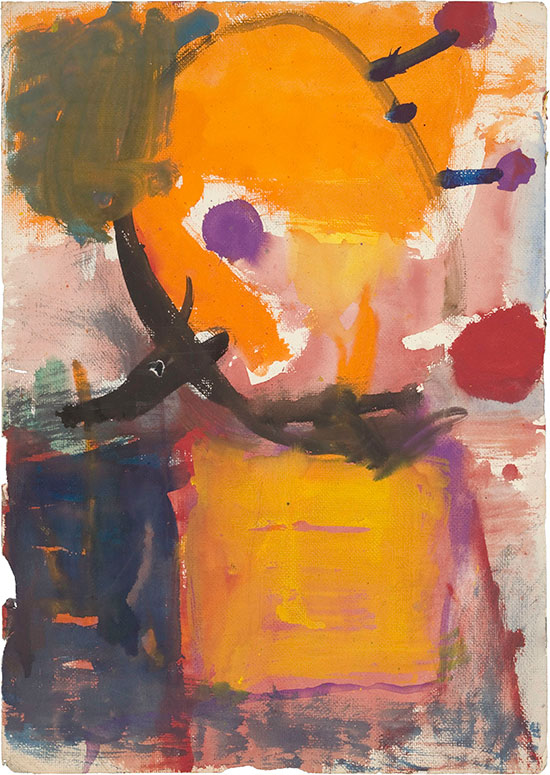
"Untitled" by Richard Diebenkorn, c. 1949. Gouache on paper, 19 5/8 x 13 7/8 inches. Catalogue raisonné no. 625.
.
With respect to the theme of “awkwardness,” one of her comments on the Gorky-like black lines (an acknowledged influence on this period, as there had been a major Gorky exhibition in San Francisco just at this time) seemed especially valuable: “It’s like he is learning some kind of alphabet,” Rockburne noted. She was clearly enjoying her dialogue with Diebenkorn, isolating passages along the way. “It is so interesting to see this work,” she said, “and especially to watch the struggle with an aspect of figuration.”
Following her eyes, and Diebenkorn’s eager brush, I vicariously and gratefully pursued the heroic course that a young artist follows, even into the desert, to his destiny.
“In Albuquerque in a sense I was on my own,” Diebenkorn said in an interview with Mark Lavatelli in 1978. “I think I was saying to myself in Albuquerque that, OK, I’m going to damn well paint what I want, I'm not going to do this qualifying of my intuitive responses. I’m going to lay it out and that’s the way it is. So if grass green and sky blue and desert tan; if these associations come into the work, so they do, that’s part of my experience.”
_________________________
BASIC FACTS: “Richard Diebenkorn: Early Color Abstractions 1949-1955,” January 13 to March 5, 2016, at Van Doren Waxter, 23 East 73rd Street, New York 10021. www.vandorenwaxter.com.
_________________________
Copyright 2016 Hamptons Art Hub LLC. All rights reserved.
